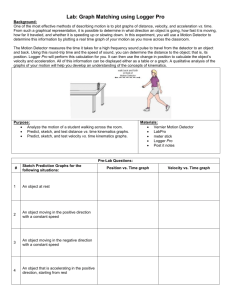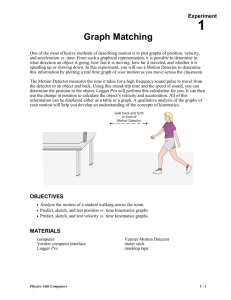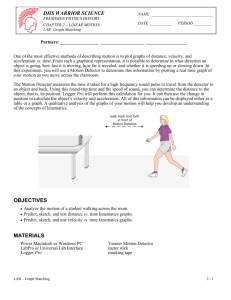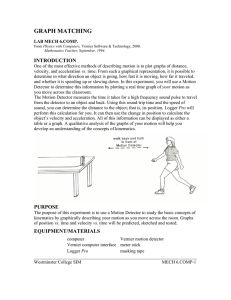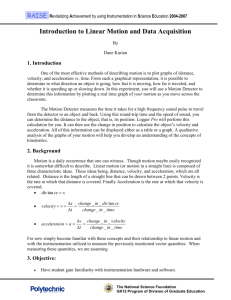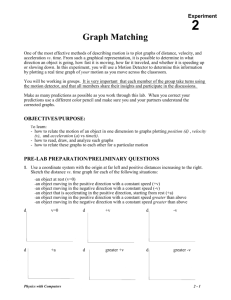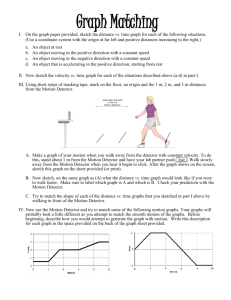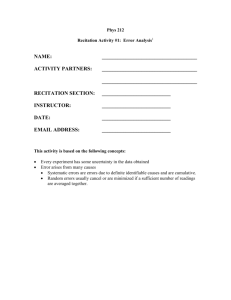Graph Matching
advertisement
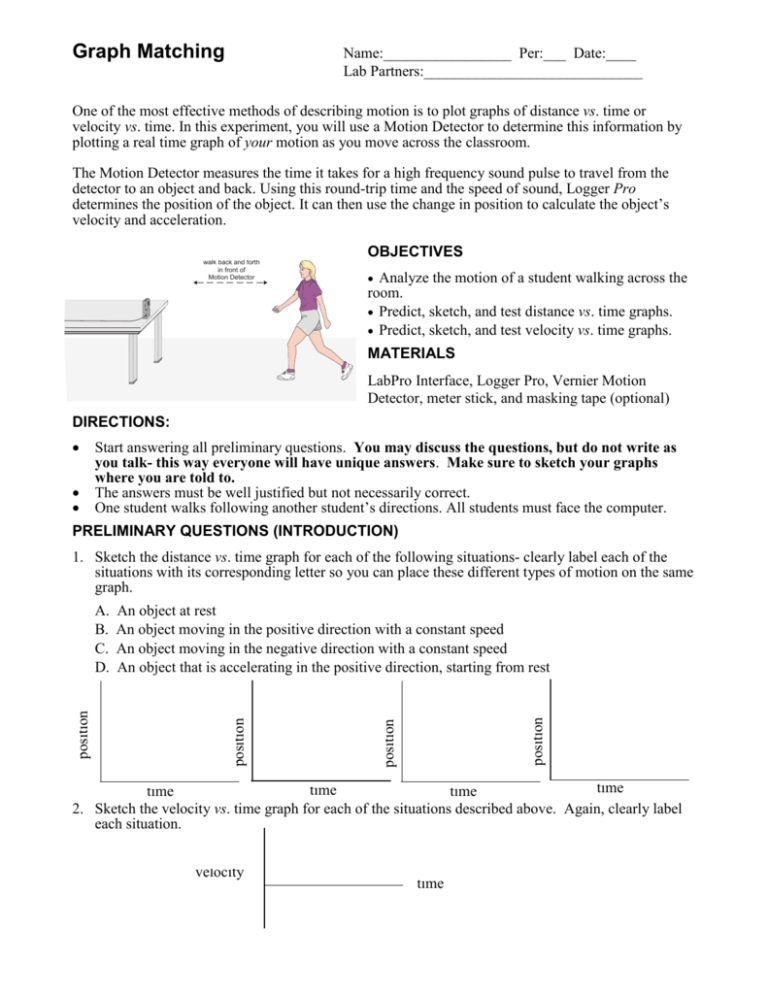
Graph Matching Name:_________________ Per:___ Date:____ Lab Partners:_____________________________ One of the most effective methods of describing motion is to plot graphs of distance vs. time or velocity vs. time. In this experiment, you will use a Motion Detector to determine this information by plotting a real time graph of your motion as you move across the classroom. The Motion Detector measures the time it takes for a high frequency sound pulse to travel from the detector to an object and back. Using this round-trip time and the speed of sound, Logger Pro determines the position of the object. It can then use the change in position to calculate the object’s velocity and acceleration. OBJECTIVES walk back and forth in front of Motion Detector Analyze the motion of a student walking across the room. Predict, sketch, and test distance vs. time graphs. Predict, sketch, and test velocity vs. time graphs. MATERIALS LabPro Interface, Logger Pro, Vernier Motion Detector, meter stick, and masking tape (optional) DIRECTIONS: Start answering all preliminary questions. You may discuss the questions, but do not write as you talk- this way everyone will have unique answers. Make sure to sketch your graphs where you are told to. The answers must be well justified but not necessarily correct. One student walks following another student’s directions. All students must face the computer. PRELIMINARY QUESTIONS (INTRODUCTION) 1. Sketch the distance vs. time graph for each of the following situations- clearly label each of the situations with its corresponding letter so you can place these different types of motion on the same graph. position position An object at rest An object moving in the positive direction with a constant speed An object moving in the negative direction with a constant speed An object that is accelerating in the positive direction, starting from rest position position A. B. C. D. time time time time 2. Sketch the velocity vs. time graph for each of the situations described above. Again, clearly label each situation. velocity time PROCEDURE Part l Check your answers to the Preliminary questions 1. Connect the Motion Detector to DIG/SONIC 2 of the LabPro. 2. Place the Motion Detector so that it points toward an open space at about 3 m long. 3. Start the Logger Pro software and open Physics with Vernier. Then open the experiment file 01a Graph Matching. 4. Using Logger Pro, produce a graph of your motion when you walk away from the detector with constant velocity. To do this, stand about 1 m from the Motion Detector and have your lab partner click Collect ; start walking slowly after you hear Motion Detector begin to click. 5. Try to match the shape of the distance vs. time graphs that you sketched in the Preliminary Questions section by walking in front of the Motion Detector. Part Il Position vs. Time Graph Matching NOTE: This is Position vs. time graph. 6. Open the experiment file 01b Graph Matching. The distance vs. time graph shown above will appear. 7. Next to the graph, write a description how you would walk to produce each graph in detail. Label the different types of motion clearly to fit your description. 8. Test your prediction by walking in front of the motion detector and collecting data as you did in previous trials. Start data collection by clicking Collect . 9. Repeat the process until your motion closely matches the graph on the screen. Each time you click the Collect button the previous data is overwritten. Explain changes that needed to be made in comparison to step 7: 10. Answer the Analysis questions for Part II. Part IIl Velocity vs. Time Graph Matching NOTE: This is a VELOCITY vs. time graph 11. Open the experiment file 01e Graph Matching. 12. Next to the graph, describe how you would walk to produce this target graph in detail. Again, label the different types of motion to clearly fit your description. 13. To test your prediction, start Logger Pro by clicking Collect . When you hear the Motion Detector begin to click, walk in such a way that the graph of your motion matches the target graph on the screen. Was your prediction correct? Explain changes that needed to be made in comparison to step 12: 14. Answer the Analysis questions for Part III. ANALYSIS- write answers in clear, complete sentence. Part II Postion vs. Time Graph Matching 1. Explain the significance of the slope on a position vs. time graph. What is the difference between positive and negative slope. 2. Using the position vs. time graph in Exp 01b, sketch a velocity vs. time graph that would indicate the same type of motion. 3. What type of motion is occurring when the slope of a position vs. time graph is zero? 4. What type of motion is occurring when the slope of a position vs. time graph is constant? 5. What type of motion is occurring when the slope of a position vs. time graph is changing? Part III Velocity vs. Time Graph Matching 6. Using the velocity vs. time graph in Exp 01e, sketch a position vs. time graph that shows the same type of motion. (Hint, start with t=0 at 1m) 7. What does the area under a velocity vs. time graph represent? 8. What type of motion is occurring when the slope of a velocity vs. time graph is zero? 9. What type of motion is occurring when the slope of a velocity vs. time graph is not zero? 10. Using Logger Pro, find the displacement of your walker over the interval of 0s to 6s. PART – IV Accelerating Motion graphs. Optional 1. Using the Motion detector and Logger Pro, create a graph of position vs time where it shows a body constantly accelerating away from the detector for a period of 3s. First discuss with your group what the graph should look like and draw the graph on a piece of paper and attach it to your lab. 2. Now, create the graph using the motion detector and logger pro. Print out this graph and attach it to your lab. Analysis: 1. Discuss why the graph shows constant acceleration. 2. Discuss and then describe with your group how to find the instantaneous velocity of the body in motion on the graph that was just created at 2s. 3. Using Logger Pro, determine the instantaneous velocity of your graphed motion at 2s. Leave this data on the graph, print the graph and keep it with your lab.

